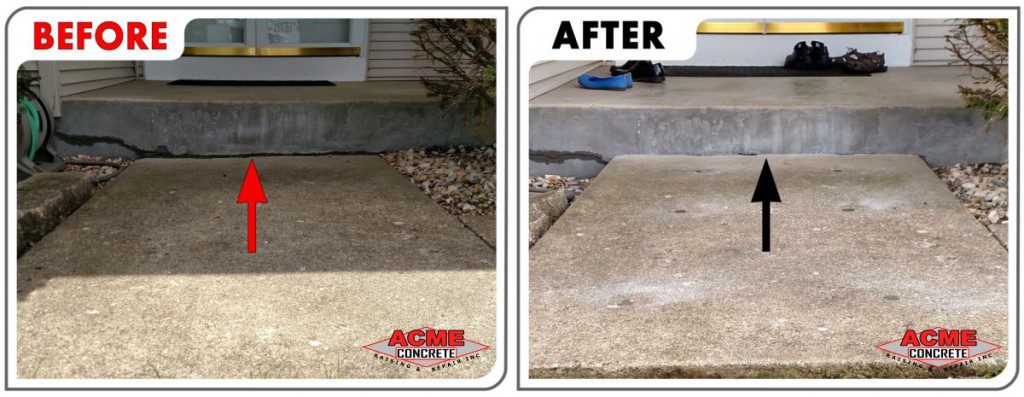This Crystal Lake case study shows how Acme Concrete corrected an improper step height using polyurethane lifting. It also teaches homeowners how to measure step height and spot trip hazards using simple tools and widely used residential thresholds.

Key Takeaways (Q&A format)
Q: What are the typical residential thresholds for step height and trip hazards in Crystal Lake, IL?
A: Many residential codes cap stair risers at 7-3/4 inches and define a trip hazard as a change in level greater than 1/4 inch; always confirm with your local authority.
Q: How does polyurethane concrete raising fix an improper step height at a Crystal Lake home?
A: Technicians inject lightweight foam beneath sunken slabs to lift and support concrete, restoring a safe, consistent step up to the stoop or entry.
Q: What should a Crystal Lake home seller do after an inspection flags step-height issues?
A: Schedule professional lifting quickly to bring the entry back within typical thresholds and keep the sale moving.
Correcting a Step Height Code Violation in Crystal Lake, IL
The situation
During a home sale in Crystal Lake, an inspection flagged the front stoop for an improper step height. Our crew responded fast and lifted the adjacent sidewalk by roughly three inches, blending panels for a smooth, natural approach. On similar projects, sidewalk lifts commonly range from two to five inches, depending on the layout and how far we must blend to the driveway or another stopping point.
Why step height and slab offsets matter
Oversized risers make entries feel awkward and unsafe, especially for older adults, kids, and anyone carrying packages. Vertical offsets between slabs can catch a toe, stroller wheel, or cane—classic trip-hazard scenarios. Addressing settlement protects visitors, reduces liability, and prevents delays during a real-estate transaction.
How to check your step height and trip hazards (DIY)
Tools: tape measure, straightedge (or long level), and a phone for photos.
Measure risers: Typical residential codes limit risers to 7-3/4 inches. Measure the last step up to the stoop; if it reads higher than 7-3/4 inches, note it for correction (confirm with your local building department).
Check slab offsets: Lay a straightedge across joints along the path to the door. A change in level greater than 1/4 inch is commonly treated as a trip hazard.
Look for settlement clues: Pooled water, soil washouts, or gaps under slab edges suggest voids or sinking.
Document and act: Photograph issues and locations. If measurements exceed typical thresholds, schedule a professional assessment.
How we fix it
Acme Concrete lifts and supports settled slabs with polyurethane concrete raising, a clean, precise method that restores alignment without major disruption. For added control on complex entries, our Smart Lift System® helps regulate lift points and stabilize slabs as they rise. If your concern is primarily uneven panels along walkways, see our guidance on managing concrete trip hazards to keep paths safe and accessible.
What to expect during service
Targeted lift points to raise the sidewalk near the stoop and blend adjacent panels smoothly.
Minimal disruption to landscaping and hardscapes, with small injection sites and tidy cleanup.
Restored curb appeal thanks to aligned joints and a consistent, comfortable step into the home.
FAQs
How much lift is usually needed to correct an entry step in Crystal Lake?
Each site is unique, but many entries need a modest elevation to bring the last riser back under the typical 7-3/4-inch cap. Technicians measure risers and offsets, then plan lift points for a smooth blend to neighboring panels. The goal is a natural-looking approach that feels comfortable on the first try.
Will polyurethane injection damage my stoop or landscaping?
Polyurethane is designed for precision with minimal disturbance. Small injection ports and controlled lift points help protect the stoop, flower beds, and lawn edging while filling voids and supporting the slab. Most projects wrap up with little visible impact beyond neatly patched ports.
How long does the repair last once step height is corrected?
The material is engineered to be stable, lightweight, and water-resistant, helping it resist future settlement from washout or weak soils. Long-term performance improves when drainage is managed and downspouts move water away from the walkway. Your technician will review site conditions and simple maintenance tips.
Can I just grind down a high edge if the change is over 1/4 inch?
Grinding can reduce small offsets on thick, sound concrete, but it does not fix underlying settlement or voids. If multiple panels have dipped or the top riser exceeds 7-3/4 inches, lifting is usually the safer, more comprehensive approach. A quick assessment will determine whether grinding, lifting, or a combination makes sense.
Will this help with a pending home sale?
Yes. Correcting oversized risers and offsets shows buyers the safety issue has been handled professionally and helps satisfy inspection concerns. Before-and-after measurements and photos provide clear documentation for agents, inspectors, and buyers.
Ready to bring your step height back within the 7-3/4″ limit and eliminate 1/4″ trip hazards? Contact Acme Concrete to schedule a quick on-site assessment in Crystal Lake and nearby communities.
